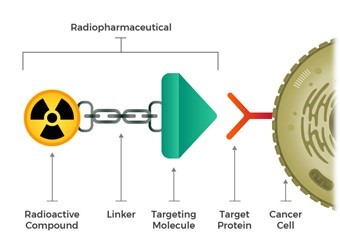Theranostics Cancer Treatment
This form of cancer treatment uses radioactive medicine to combine diagnostic imaging and therapy to provide our patients with a targeted treatment option. Part of this option includes Radiopharmaceuticals.
Radiopharmaceuticals
Karmanos has been a pioneer in the use of radiopharmaceuticals, participating in landmark clinical trials and offering these treatments since 2017. Radiopharmaceutical therapy (RPT) is a treatment technique that uses a drug which carries a radioactive compound that targets cancer cells. RPT targets cancer cells specifically, sticking to them and breaking them down over time, and reduces the amount of radiation exposure to normal, healthy tissue. The treatment is delivered intravenously (through an IV) and is often recommended for patients whose disease has not previously responded to other lines of treatment.

Graphic by The National Cancer Institute
Types of Radiopharmaceuticals
- Lutathera™: A targeted agent used to treat neuroendocrine tumors that have spread throughout the body. This treatment is delivered through an intravenous injection once every eight weeks for a total of four injections.
- Pluvicto™: A targeted agent used to treat metastatic prostate cancer . This treatment is delivered through an intravenous injection once every six weeks for a total of six injections.
- Xofigo®: A targeted agent used to treat bone metastatic prostate cancer that is no longer responding to androgen deprivation therapy. This treatment is delivered through an intravenous injection once every four weeks for a total of six injections.
A PET scan is needed for both Lutathera® and Pluvicto® to image the disease. For this PET scan, an imaging drug is used instead of the therapeutic radiation emitter. This scan then allows us to determine whether the tumor receptor is present and, if so, where the cancer cells are located. Next, the therapeutic radiation emitter Lu-177 is attached to the targeting molecule and administered to the patient. The drug will then find and bind to the tumor cells and release DNA-damaging radiation to kill the cancer. Additional cancer imaging and treatment drugs are currently under investigation at the Karmanos Cancer Institute to help develop future treatments.
Radiopharmaceuticals can also detect the amount and location of the cancer cells. In this case, they are also sometimes called “theranostics,” meaning they can perform both diagnosis and therapy.
What are the potential side effects of Radiopharmaceuticals?
While being treated using radiopharmaceuticals, you will carry some radioactivity within your body and release some through bodily excretions. Depending on the time it takes for the agent to release its energy, you will be given specific instructions on reducing exposure to those around you.
When patients receive conventional radiation cancer therapy, X-rays are targeted at the tumor and delivered using external beams. During delivery, the radiation has to travel through healthy tissue on the path to the disease. When the cancer has spread throughout the body, treating multiple parts of the body with traditional external beams of radiation can increase the risk of significant side effects.
Side effects are specific to the type of radiopharmaceutical used. General side effects include, but are not limited to, fatigue, nausea, vomiting, low blood counts, and decreased kidney and liver function. RPT is only available for specific cancer types. Karmanos evaluates all patients with these types of cancers to determine whether RPT is right for them. If you are a candidate for radiopharmaceutical therapy, your radiation oncologist will discuss the treatment with you. You can rest assured that you will receive the most accurate, highest-quality treatment we can provide.